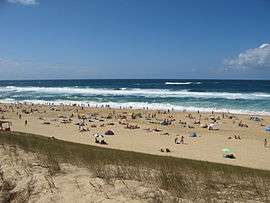Landes (department)
The Landes (French pronunciation: [lɑ̃d]; Gascon: Lanas [ˈlanəs]) are a department in southwestern France and in the south half of the region Nouvelle-Aquitaine.
Landes Lanas | |
|---|---|
Prefecture building of the Landes department, in Mont-de-Marsan | |
 Flag  Coat of arms | |
 Location of Landes in France | |
| Coordinates: 44°0′N 0°50′W | |
| Country | France |
| Region | Nouvelle-Aquitaine |
| Prefecture | Mont-de-Marsan |
| Subprefectures | Dax |
| Government | |
| • President of the General Council | Henri Emmanuelli |
| Area | |
| • Total | 9,243 km2 (3,569 sq mi) |
| Population (2016) | |
| • Total | 405,010 |
| • Rank | 60th |
| • Density | 44/km2 (110/sq mi) |
| Time zone | UTC+1 (CET) |
| • Summer (DST) | UTC+2 (CEST) |
| Department number | 40 |
| Arrondissements | 2 |
| Cantons | 15 |
| Communes | 327 |
| ^1 French Land Register data, which exclude estuaries, and lakes, ponds, and glaciers larger than 1 km2 | |
History
Landes is one of the original 83 departments that were created during the French Revolution on 4 March 1790. It was created from parts of the provinces of Guyenne and Gascony.
During the first part of the nineteenth century large parts of the department were covered with poorly drained heathland (lande in French) which is the origin of its name. The vegetation covered rich soil and was periodically burned off, leaving excellent pasturage for sheep, which around 1850 are thought to have numbered between 900,000 and 1,000,000 in this area. The sheep were managed by shepherds who moved around on stilts and became proficient at covering long distances thus supported. Most of the sheep departed during the second half of the nineteenth century when systematic development of large pine plantations transformed the landscape and the local economy.
One of the most famous citizens of the Landes was the nineteenth-century French economist Frederic Bastiat.
The Nobel Prize–winning novelist François Mauriac set his novels in the Landes.
Geography
The Landes is part of the current region of Nouvelle-Aquitaine and is surrounded by the departments of Gironde, Lot-et-Garonne, Gers, and Pyrénées-Atlantiques, as well as the Atlantic Ocean on the west. With an area stretching over more than 9000 km², Landes is, after Gironde, the second largest department of the metropolitan French territory.
It is well known for the Côte d'Argent beach which is Europe's longest, and attracts many surfers to Mimizan and Hossegor each year.
It is also home to a château called Château de Gaujacq that was built in 1686.
Demographics
Population development since 1801:
| Year | Pop. | ±% p.a. |
|---|---|---|
| 1801 | 224,272 | — |
| 1806 | 240,146 | +1.38% |
| 1821 | 256,311 | +0.44% |
| 1831 | 281,504 | +0.94% |
| 1841 | 288,077 | +0.23% |
| 1851 | 302,196 | +0.48% |
| 1861 | 300,839 | −0.04% |
| 1872 | 300,528 | −0.01% |
| 1881 | 301,143 | +0.02% |
| 1891 | 297,842 | −0.11% |
| 1901 | 291,586 | −0.21% |
| 1911 | 288,902 | −0.09% |
| 1921 | 263,937 | −0.90% |
| 1931 | 257,186 | −0.26% |
| 1936 | 251,436 | −0.45% |
| 1946 | 248,395 | −0.12% |
| 1954 | 248,943 | +0.03% |
| 1962 | 260,495 | +0.57% |
| 1968 | 277,381 | +1.05% |
| 1975 | 288,323 | +0.55% |
| 1982 | 297,424 | +0.44% |
| 1990 | 311,461 | +0.58% |
| 1999 | 327,334 | +0.55% |
| 2006 | 362,827 | +1.48% |
| 2011 | 387,929 | +1.35% |
| 2016 | 405,010 | +0.87% |
| source:[1] | ||
Politics
The President of the General Council is Xavier Fortinon.
| Party | seats | |
|---|---|---|
| • | Socialist Party | 24 |
| • | French Communist Party | 2 |
| Union for a Popular Movement | 2 | |
| New Centre | 1 | |
| Miscellaneous Right | 1 | |
Current National Assembly Representatives
Economics
In terms of agriculture, the Landes is known for its large pine forest which is the raw material for a timber and resin industries in the region. The forest was planted in the early nineteenth century to prevent erosion of the region's sandy soil by the sea.
Tourism
.jpg) Surfer in Hossegor
Surfer in Hossegor Beach near Messanges
Beach near Messanges- Landes forest, the largest maritime-pine forest in Europe
See also
References
External links
| Wikimedia Commons has media related to Landes. |
- (in French) Prefecture website
- (in French) Conseil Général website
- (in English) Landes at Curlie